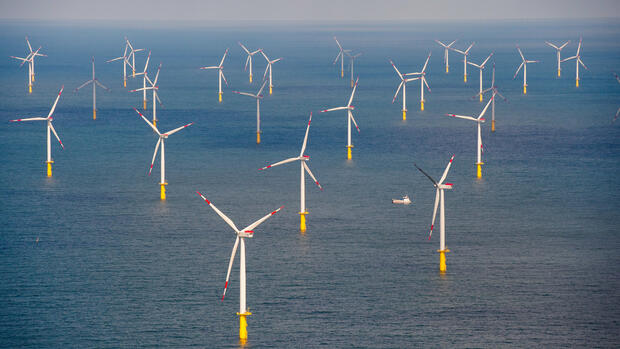Wind power on the water is to be greatly expanded as part of the energy transition.
(Photo: dpa)
Berlin The world’s largest tender for areas for offshore wind farms to date has had a surprising result: interested parties are not only waiving any legally guaranteed feed-in tariffs. According to the Federal Network Agency, they even add a total of 12.6 billion euros “entrance fee” on top. The successful bidders are led by BP and Total Energies, two major oil companies.
This ended on Wednesday the auction of four areas for offshore wind power in the North and Baltic Seas with a potential of seven gigawatts (GW) of installed capacity. The areas are around 120 kilometers northwest of Heligoland and 25 kilometers north of Rügen. A call for tenders of this magnitude is globally unprecedented.
The tendering procedure was also new in Germany. A first bidding round ended with bids at zero cents per kilowatt hour. This means that all bidders were willing to forego a legally guaranteed payment per kilowatt hour of electricity produced.
A second round then started for the first time, the so-called “dynamic bidding process”: The bidders with the highest willingness to pay for a space were awarded the contract.
Industry experts feel their forecasts have been confirmed by the result. “There is increasing market pressure, which is reflected in the result,” said Dirk Briese from the consulting firm Wind Research. “While it is not surprising that applicants offer money to win the contract. But the amount of the bids is remarkable.”
Industry is very interested in green electricity
The result shows that wind power is in high demand. “The bidders know that electricity from green sources can be marketed very well and will continue to improve in the future,” said Briese. Industry in particular has expressed great interest.
Stefan Thimm, Managing Director of the Federal Association of Offshore Wind Farm Operators, said the successful bidders showed their strong commitment to the further expansion of offshore wind energy in Germany with their bids. “The results of the auctions underline the great willingness of investors to support the expansion of this established technology,” he said.
The traffic light coalition is pursuing ambitious goals in expanding offshore wind power. By 2030, 30 GW of offshore wind power is to be installed in the North and Baltic Seas. In 2035 it should be 40 GW. Wind turbines with a capacity of around eight GW are currently turning in the German part of the North and Baltic Seas.
Thimm said that the industrial policy foundations must now be laid so that the winners of the auctions can successfully implement their projects. “We need political support to eliminate the foreseeable bottlenecks in the value chain, for example in the industrial capacity for the construction of wind turbines, foundations and the ships required for this,” said the head of the association.
Industry had warned of outbidding competition
The industry had criticized the new auction procedure in advance and warned against an overbidding competition at the expense of electricity consumers. The electricity produced in the parks yet to be built from the latest round of tenders will not be sold on the electricity market, but via direct purchase agreements between wind farm operators and individual companies. In technical jargon, these contracts are called “Purchase Power Agreements” (PPA).
Such contracts are popular in industry because they pave the way for decarbonization. But the operators will recover the twelve billion euros they had to pay to get the contract from electricity customers by calculating the electricity prices of the PPAs accordingly, experts predict.
This contradicts the federal government’s goal of curbing electricity prices for industry as much as possible, because only individual large customers benefit from direct contracts. The Ministry of Economics is even striving to make offshore wind power available to industry at particularly favorable conditions in the future.
The proponents of the new auction process counter that 90 percent of the 12.6 billion euros should flow into reducing electricity costs, five percent each go to marine protection and the promotion of environmentally friendly fishing.
More: This is what the German hydrogen network should look like
